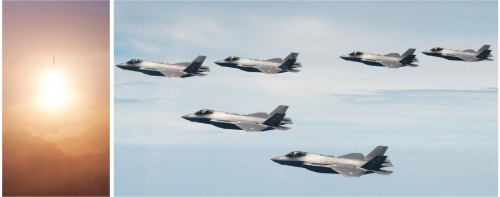 |
| North Korea launched an intercontinental ballistic missile (ICBM) off its east coast on Thursday in the presence of its leader Kim Jong-un. In response, South Korea and the U.S. Air Forces conducted large-scale aerial maneuvers as part of the Freedom Flag 2024 exercise. South Korea’s F-35A, F-15K and KF-16 fighter jets equipped with precision-guided weapons, flew in formation with U.S. F-35B and F-16 fighters, as well as the MQ-9 unmanned aerial vehicle./ Source: Yonhap, Joint Chiefs of Staff (JCS) |
AsiaToday reporter Hong Sun-mi
North Korea launched an intercontinental ballistic missile (ICBM) into the East Sea on Thursday.
The move is interpreted as its intention to solidify its reputation as a “nuclear power” with a new ICBM designed to threaten the U.S. mainland ahead of the U.S. election. President Yoon Suk-yeol has instructed the National Security Council (NSC) to respond strongly to the North’s provocations and prepare thoroughly so the North cannot carry out any surprise provocations. The South Korean government has decided to impose new unilateral sanctions against the North in response to the latest provocation.
The Joint Chiefs of Staff (JCS) said it detected a projectile, deemed to be a nuclear-capable ICBM, fired at a lofted angle from Pyongyang area at around 7:10 Thursday morning. After flying about 1,000 kilometers from the launch site, the missile reportedly landed in waters of the East Sea, according to the JCS.
“The South Korean, U.S. and Japanese authorities have been prepared to jointly detect and track, and North Korea’s ballistic missile warning information has been closely shared among the three countries in real-time,” the JCS said. “The defense ministers of South Korea and the U.S. agreed to demonstrate the alliance’s determination for a response by strongly carrying out various measures, such as combined drills involving the deployment of U.S. strategic assets,” it said.
Thursday’s launch came 10 months after the North fired a Hwasong-18 solid-fuel ICBM on Dec. 18.
The Japanese government announced that the projectile soared to a maximum altitude of around 7,000 kilometers, and flew for around 86 minutes before landing in waters west of Hokkaido outside Japan’s exclusive economic zone. The projectile soared longer than any other ballistic missile North Korea has launched so far. According to the defense ministries of South Korea and Japan, the latest ICBM is estimated to be an improved version of the Hwasong-18, which is capable to hitting the entire U.S. mainland with a range of more than 15,000 kilometers.
The presidential office held an emergency NSC standing committee meeting presided over by National Security Adviser Shin Won-sik. The NSC standing members noted the ICBM launch constituted another violation of U.N. Security Council resolution following the North’s deployment troops to Russia’s war on Ukraine, and strongly denounced the North’s provocations as a serious threat to peace and safety on the Korean Peninsula and in the world.
#North Korea #ICBM #JCS #election
Copyright by Asiatoday
Most Read
-
1
-
2
-
3
-
4
-
5
-
6
-
7





















